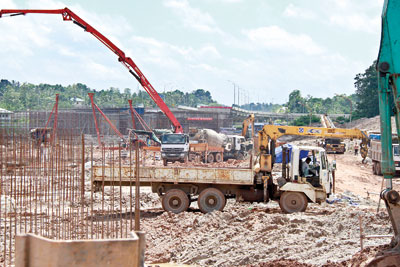News
Central Expressway will worsen Kandy congestion, warn transport experts
The proposed Central Expressway will escalate congestion in and around Kandy and worsen gridlock in the crowded historic city, transport experts warn.They recommend investment in rail transport as an alternative, pointing out that train travel is much faster (even now) and will convey more people without the risk of further jamming Kandy.

The Central Expressway in progress. Pic by Indika Handuwala
It now takes around four hours and 40 minutes to reach Kandy or Colombo by road. The Colombo-Kandy track carries nine trains a day, up to 13 in the weekend. Of these, the intercity trains reach their destination in 150 minutes–nearly half the road time.
“We already have a speed advantage of 80 minutes,” pointed out Amal Kumarage, a transport and logistics professional from the University of Moratuwa. Prof Kumarage was among experts at a panel discussion called by the Mechanical Engineering Sectional Committee of the Institution of Engineers and the Sri Lanka Society of Transport & Logistics to press policymakers to develop rail transport. The speakers included Ranjith Dissanayake, a railway professional who has authored several books on the subject, former General Manger of Railways Priyal de Silva and Lalithasiri Gunaruwa, a transport economist and also former GMR.It is widely reported that a four-lane expressway will enable commuters to reach Kandy from Colombo in one hour, Prof Kumarage observed.
The experience of the Colombo-Katunayake expressway shows, however, that it could take that long at rush-hour just to get to the entry point at Kadawatha.“We know that we cannot build highways and expect traffic congestion to reduce,” Prof Kumarage said. Around Rs 51bn was spent on the Colombo-Katunayake expressway. “The Road Development Authority is now spending Rs 40bn more to bring traffic from that side of the bridge to inside of Colombo,” he observed.
“I think you will need Rs 100bn more to take it from there, with several elevated roads being proposed, to places like Rajagiriya.”The Central Expressway was first called the Colombo-Kandy Alternate Highway and thereafter Northern Expressway. Initially, in 2001 a two-lane highway had been proposed between Ambepussa and Galagedara. Deviations were made to the trace in 2013 and 2014 and the cost escalated significantly. The two-lane highway became a four-lane expressway and several interchanges were added, despite estimated traffic volume remaining the same in studies.“As an engineer, I can’t understand the logic of how when the traffic comes down the design and price goes up, and when the traffic stays the same it goes from a two-lane highway to a four-lane expressway,” Prof Kumarage said.
“If you actually look at the travel time between four lanes and two lanes, the saving is five minutes,” he continued. “You will save only five minutes if that 34 km section is considered two-lane or non-expressway standard. But the cost will come down by more than 50 percent.” Both interchanges and expressway standards are expensive to maintain.
The experts proposed, in addition to a two-lane highway, the building of a new track from Rambukkana to Kandy using a fresh trace. “You can do both and still have money left,” Prof Kumarage pointed out. If 40 trains per day could be deployed to Kandy by 2036, 18,000 people can be transported by rail and 22,000 people by road.
“What we will basically require is another well-engineered, two-lane road that can reach 80km per hour,” he said. “That will be more than adequate.” As an immediate measure, the track between Rambukkana and Kadugannawa could be improved at a relatively low cost of Rs 11.5bn with the addition of colour-lights, said Mr de Silva.
This would reduce the travel time to Kandy by 40 minutes to 110 minutes and will cost only eight percent of what is being spent on the expressway.
Despite the cost of the Central Expressway having tripled, even quadrupled, in recent times, policymakers insist it is viable. However, none of the studies considered other modes of transport. This is a violation of the planning process required by the Central Environmental Authority and the National Planning Department which required alternatives to be studied. It is not too late to assess the feasibility of the rail option to Kandy, the experts stressed. Some design changes may need to be done but the railway must be considered as it will have less impact on traffic congestion in Colombo and Kandy.
In the long-term it was proposed by Mr Dissanayake that a high-speed rail service can run, on average, up to 150km per hour, thereby reaching Kandy or Colombo in less than one hour. “Kandy takes in about 60,000 vehicles a day and that’s the maximum,” Prof Kumarage said. “There’s no way you can bring more vehicles into Kandy, unless you want to tunnel into the city or put elevated structures and destroy its heritage value.” This number of vehicles will have to be managed. In the next ten years, congestion pricing and other mechanisms might need to be introduced. “Therefore, there’s a serious question of whether you want to bring an additional 10,000 vehicles to Katugastota Bridge and dump them there,” he said. “And there are only actually four major bridges to come into Kandy. Wherever you bring the vehicles, they will start circulating this way or that.” This is what happened with the Colombo-Katunayake expressway. “Now we know how much it’s going to cost to fix that problem,” he said.
“The RDA will have to build another bridge across the Mahaweli, maybe more. Even then the traffic will go into Kandy and you will have to talk about flyovers and things like that. I think we need to look at preventing the problem.”

